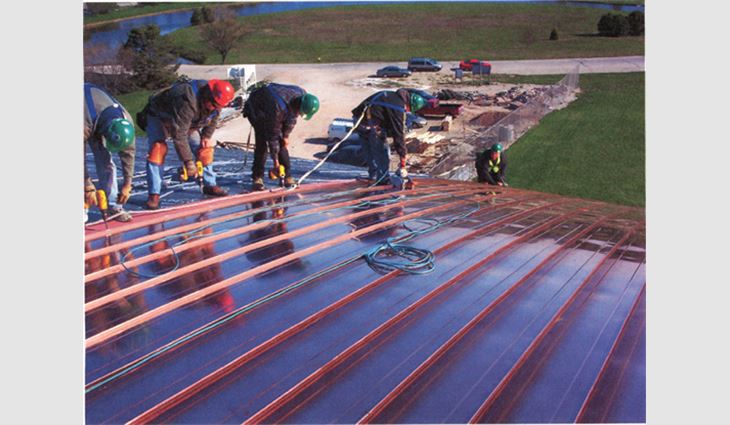 Photo courtesy of Carlson Racine Roofing & Sheet Metal.
Photo courtesy of Carlson Racine Roofing & Sheet Metal.
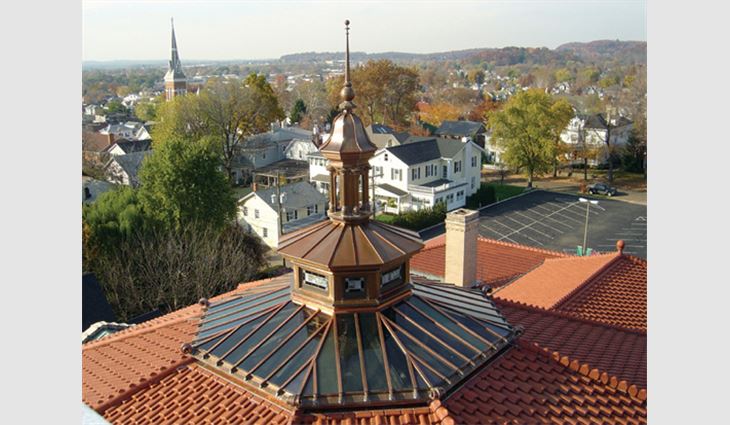 Photo courtesy of The Durable Slate Co., Columbus, Ohio.
Photo courtesy of The Durable Slate Co., Columbus, Ohio.
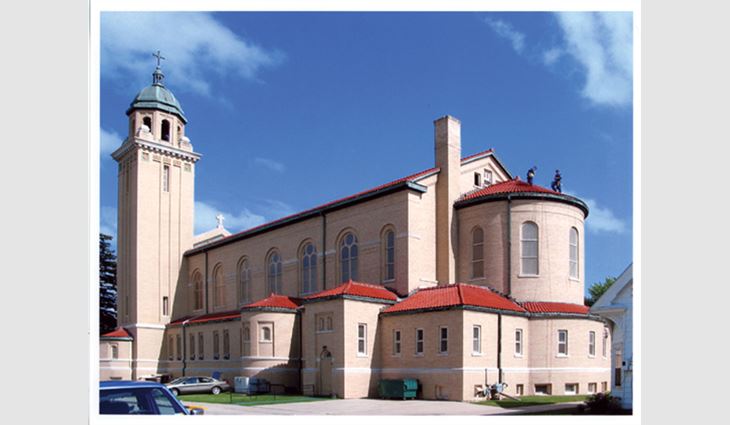 Photo courtesy of Interstate Roofing & Waterproofing Inc., Onalaska, Wis.
Photo courtesy of Interstate Roofing & Waterproofing Inc., Onalaska, Wis.
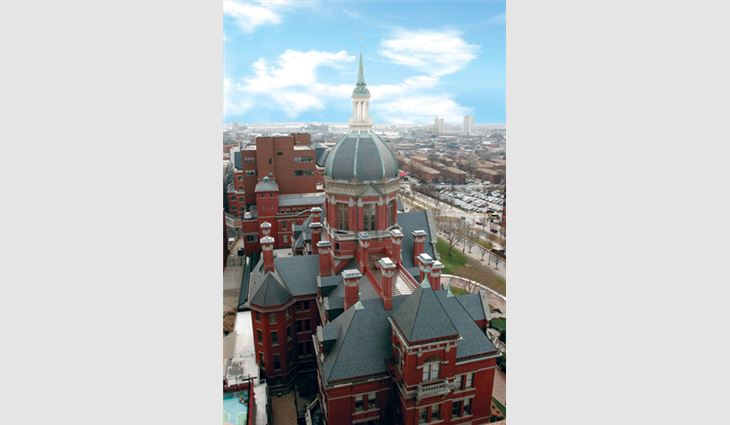 Photo courtesy of Ruff Roofers Inc., Baltimore.
Photo courtesy of Ruff Roofers Inc., Baltimore.
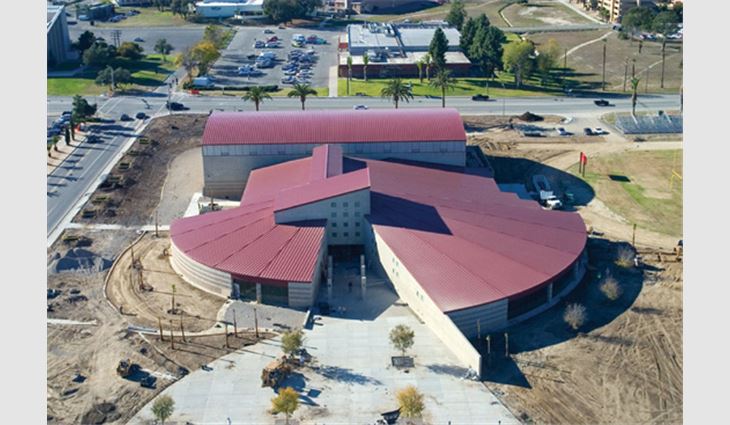 Photo courtesy of Keystone Roofing Inc., Oceanside, Calif.
Photo courtesy of Keystone Roofing Inc., Oceanside, Calif.
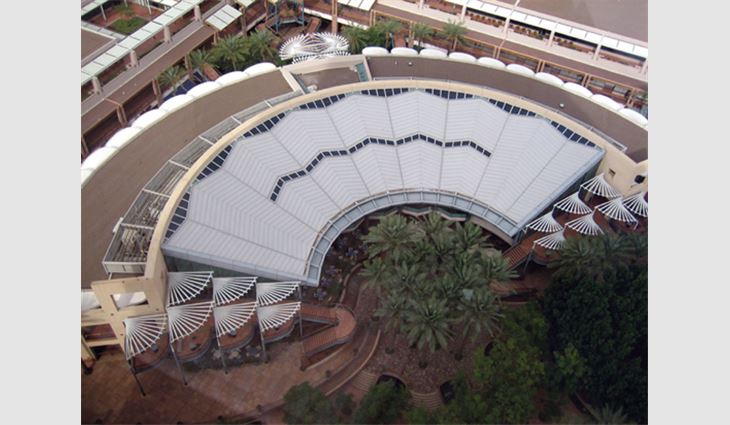 Photo courtesy of Clark's Quality Roofing, Murray, Utah.
Photo courtesy of Clark's Quality Roofing, Murray, Utah.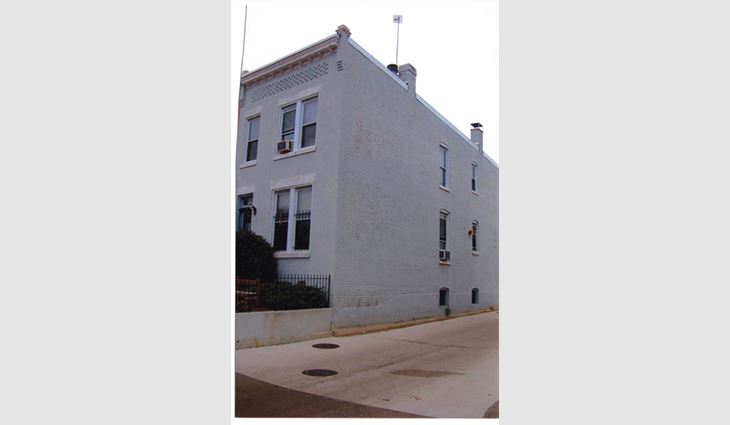 Photo courtesy of Denchfield Roofing Corp., Silver Spring, Md.
Photo courtesy of Denchfield Roofing Corp., Silver Spring, Md.
Since 1995, NRCA annually has honored outstanding contributions to the roofing industry by recognizing NRCA members who have met standards of achievement in four categories: outstanding workmanship, innovative solutions, service to the community and service to the industry.
This year, at NRCA's 119th Annual Convention in Las Vegas, deserving NRCA members received the 2006 Gold Circle Awards for challenging projects, unique solutions and community involvement. Following are descriptions of the winning projects.
Gold Circle Award category: Outstanding workmanship—low slope
Recipient: Carlson Racine Roofing & Sheet Metal Inc., Racine, Wis.
Project: Johnson Athletic Center, Racine
Roof system types: Standing-seam copper roof system, SBS-modified bitumen and fully adhered EPDM
A college-preparatory day school, the Prairie School is settled on the shores of Lake Michigan in Racine. All its buildings were designed by Charles Montooth, an apprentice of Frank Lloyd Wright. Wright's influence on Montooth's work is evident in the unique campus buildings.
One of the buildings, the new Johnson Athletic Center, required a challenging roof system installation. Carlson Racine Roofing & Sheet Metal was chosen to install two standing-seam copper barrel roof systems, an SBS-modified bitumen membrane roof system and a fully adhered EPDM roof system.
Design
Because of the complicated design, Carlson Racine Roofing & Sheet Metal was asked to assist with architectural plans and application techniques during the project's design phase.
"The architects left the actual design work for the panels and intricate details up to Carlson Racine Roofing & Sheet Metal," says Steve Joost, Prairie School business administration manager.
The building's roof area is 65,000 square feet (6039 m²), and Carlson Racine Roofing & Sheet Metal covered the roof and fascias with more than 38 tons (34 Mg) of 16-ounce copper. The company installed a standing-seam copper metal roof system with a double-hem lock seam on the barrel roofs, which had 12-in-12 (45-degree) slopes at the steepest point and 35-foot- (11-m-) high eaves.
"The copper panels were mechanically anchored over NRG 3 1/2-inch (89-mm) nailbase insulation over a 6-mil- (0.006-inch- [0.2-mm-]) thick vapor barrier and 1/2-inch- (13-mm-) thick DensDeck installed on a Type 'B' structural steel deck," says Greg Petersen, owner of Carlson Racine Roofing & Sheet Metal. "The sidewall fascia panels consisted of 1 1/2-inch (38-mm) snap-lock 16-ounce standing-seam panels."
On the areas between the two barrel roofs, the company installed two additional roof systems. One was a Johns Manville 90-mil- (0.09-inch- [2-mm-]) thick EPDM fully adhered roof system over tapered polyisocyanurate insulation. The other was a Johns Manville modified bitumen roof system with tapered polyisocyanurate insulation; 1/2-inch- (13-mm-) thick retrofit board; two plies of type 6 fiberglass felt; and a DynaKap FR SBS-modified bitumen cap sheet.
Complications
Besides an already complicated installation, the project presented other challenges.
"The first panels installed were on the link roof between the existing building and new fieldhouse," Petersen says. "These panels had to be run out of a scissors truck raised 18 feet (5 m) in the air, carried over the scaffolding and installed on the roof system. After the low-slope roof was completed, we lifted our panel machine onto it. Many panels were more than 80 feet (24 m) long and difficult to handle on the windy shores of Lake Michigan."
But the challenges also added to the project's uniqueness.
"Besides the fact that there are two intersecting copper barrel roofs tying into an existing third segmented copper barrel roof, we also had to deal with an inlaid copper gutter system and diverter that encompassed the roof 3 feet (1 m) in from the outside edge around the perimeter," Petersen says.
There were many safety issues involved with the project, as well.
"With the unprotected edges, slope and height of the building, safety concerns were plentiful," Joost says. "And having an Occupational Safety and Health Administration (OSHA) inspector living in the general vicinity didn't make things any easier. We had many unannounced site inspections. The tie-off points had to be moved constantly as work progressed along each roof line at elevations reaching more than 65 feet (20 m). It is a credit to Carlson Racine Roofing & Sheet Metal's safety procedures that the entire roofing segment of this project was completed with no safety incidents or OSHA violations."
Surrounded by talent
Joost was happy with the result.
"The finished product exceeded our expectations and was completed on time, even when a majority of the work was performed during harsh winter weather," he says. "We trusted Carlson Racine Roofing & Sheet Metal's design involvement and expertise to complete what we believe is one of the most beautiful athletic facilities in the U.S. Trusting and working with some talented, professional people at Carlson Racine Roofing & Sheet Metal was rewarding."
In addition to participating in such a unique project, the people who worked on the project made it worthwhile, Petersen says.
With regard to the Gold Circle Award, "Our peers recognize the work at Carlson Racine Roofing & Sheet Metal is and always will be first-class," Petersen says. "We're only as good as the people we work with, and in this case, those people were pretty darn good."
Gold Circle Award category: Outstanding workmanship—steep slope
Recipient: The Durable Slate Co., Columbus, Ohio
Project: First United Methodist Church, Lancaster, Ohio
Roof system type: Solid copper sheet metal over a wood frame
The First United Methodist Church is topped with a 100-year-old cupola, which is a significant historical landmark in Lancaster. When the church decided to restore the cupola, it not only faced the challenge of reproducing part of a historic structure but also reproducing it without access to the original plans.
The Durable Slate Co. took on the challenge of fabricating the copper and installing the materials needed to recreate the structure.
Re-creation
The company removed the colonnade and bell-shaped portion of the cupola's upper section so it could begin to reproduce the framework and copper cladding. The cupola had a skylight, which the company decided to approach last to protect the glass. The glass was removed and plywood temporarily was inserted to keep the interior dry and so workers could stand on it. Then, the re-creation began.
"Every detail was painstakingly recreated to match the original structure," says Cherie Downey, director of public relations for The Durable Slate Co. "All the copper work was cleated, either lapped and riveted or lock-seamed as appropriate, and hand-soldered."
Before installation, the company installed 3/4-inch- (19-mm-) thick plywood, and a Grace Ice and Water Shield® was placed where the cupola would be installed.
The company first installed the crown roof and clad the windows in 20-ounce copper sheet metal from Corken Steel Products Co. The cupola's colonnade section then was fabricated, and the wood base was rebuilt. The bottom apron was installed after attaching the base of the cupola.
The bell roof's original frame was retained and reinforced, and the copper cladding was installed on the bell and colonnade structures. The finial, which also was fabricated by The Durable Slate Co., was placed over the existing finial pole.
The upper scaffolding then was removed to reach the skylight, and glass replacement and repair finished off the project.
"A few changes made the installation better," says Patricia Betts, business administrator for First United Methodist Church. "For instance, the way the base was reattached was improved; previously, it only had been toe-nailed to the roof. Without changing the profile or dimensions, the base of the structure was redesigned so it could be bolted to the roof.
"This was done by constructing a collar of 4 x 4 lumber, which was bolted into the rafters of the main roof with 8-inch (203-mm) lag bolts," she continues. "The framework of the column base was built with 2 x 10 lumber to fit over the outside of the collar and then bolted to the collar with 5-inch (127-mm) lag bolts."
In addition, the rotted wood sashes of the stained glass were repaired and made weathertight. The stained glass was releaded and reinstalled; although most of the glass was intact, a few pieces needed to be replaced.
Uniquely, the cupola was in the center of a skylight, which factored greatly into the restoration.
"The skylight had leaked for some time because the glazing had failed," Betts says. "Instead of fixing the glaze, which is what should have been done, someone installed more glass over the original glass and used improper materials (plumbers putty between the windows and tar) during the installation. In addition, some glass was not cut accurately and voids merely were filled with caulking that was exposed to the weather. This situation was remedied by the restoration.
"The extra layer of glass was removed, and proper skylight flashings were installed," she continues. "The glass portions of the skylight were replaced as needed. For the purpose of catching condensation, a drip pan at the lower edge of the skylight had been covered by earlier repairs. The cupola's original design did not include this covering, so the element was eliminated during restoration."
A flashing was installed over the top of the rails, and an apron was installed over that to protect the glass glazing.
A difficult task
Such a complicated project was not without its challenges.
"Those who worked on the project probably would say breaking the metal was the most challenging because there were so many curved shapes," Downey says. "The detailed copper fabrication certainly was the most tedious part of the job. The components were fabricated in the shop while the assembly was done on the roof."
The installation process was challenging for a variety of reasons.
"It was quite windy that high up with no other structures to serve as buffers," Downey says. "Working above a skylight in the middle of a tile roof presented real challenges during every step of the assembly—and there were many steps. All the coping had to be installed in place by hand. The ram's head ornaments were installed after the structure was installed on the roof. A mechanical beta hoist was used to lift the free-built columns and the bell-shaped cap with its spherical ornaments up to the main scaffolding platform for installation.
"Their size and lack of space in which to maneuver prohibited further transport by machine," she continues. "From there, it took four men to get the structures up the two remaining scaffolding levels to the rooftop."
And reproducing a complicated, historic structure was no easy task.
"The cupola structure is not an equilateral octagon," Betts says. "Four sides are longer than the others, giving the octagon an elongated shape. This unusual outline added a dimension of difficulty when fitting the cupola into the existing rafter structure.
"In addition, the irregular shape of the octagon meant none of the angles of the octagon segments measured 22 1/2 degrees," she continues. "Some were 24 degrees, and some were 21 degrees. This made the calculations and fabrication more involved than would have been the case with an equilateral polygon."
Nothing's impossible
"Completing a project that other people said couldn't be done was incredibly rewarding," Downey says. "There were people in the congregation who said the cupola had been leaking for 35 years, and they didn't think it ever could be fixed. But we knew the first thing needed was the creativity to tackle the problem and find an effective solution. After that, it would require a company with the right equipment and workers with some artistic skill. With our knowledge and experience and the artistry of our crew, we were confident we could get it done—and we did!"
And gaining recognition for the hard work was a bonus, Downey says.
"Winning this award means our work was considered outstanding by our peers," she says. "We understand this recognition is not given without deliberation, and this makes it precious. There are many projects executed with competence and care and many attractive roofs that will serve to shelter buildings. To know this project has been held up before the entire roofing industry as an example of excellence is quite thrilling."
Gold Circle Award category: Outstanding workmanship—steep slope
Recipient: Interstate Roofing & Waterproofing Inc., Onalaska, Wis.
Project: St. Patrick Catholic Church, Waukon, Iowa
Roof system type: Clay tile roof system
During the past few years, families of St. Patrick Catholic Church parish generously have donated money to restore the 90-year-old church, which required replacing its old tile roof system.
However, the church's building committee was especially concerned with the work quality for the church's radius towers and did not want to take the choice of contractor lightly.
After interviewing and requesting presentations from four companies, the church building committee chose Interstate Roofing & Waterproofing to install a clay tile roof system on the church.
Problems
Fall protection was a major issue when preparing for the roof system installation. Scaffolding could not be set up straight from the ground because a lower roof section extended 8 feet (2 m) farther from the building than the upper section.
Therefore, scaffolding was set up to the lower eave and continued directly on the lower roof deck to reach the upper eave and stayed there until the upper roof work was finished. The lower roof had to be removed and kept watertight while the upper roofing work was performed. Then, the scaffolding was set to the lower eave for roof and copper flashings removal and placement of Grace Ice and Water Shield® and a base sheet underlayment. In addition, flat platforms were constructed on the lower roof to support the upper eave scaffold.
However, Interstate Roofing & Waterproofing experienced an unpleasant surprise during the tear-off.
"During the tear-off phase of the construction project, the old copper architectural sheet-metal work was meticulously removed and stored," says Jon Kloehn, assistant vice president of Interstate Roofing & Waterproofing. "These pieces were going to be sent back to Onalaska, Wis., to be used as patterns for manufacturing the new copper architectural sheet-metal work. However, before transportation to the shop, these items were stolen!"
Unable to use the patterns, the crew studied digital photos and took precise measurements at the job site to obtain the dimensions needed to manufacture the cornice detail that hid the copper gutter system. Fortunately, these methods worked, and the architectural sheet metal fit perfectly.
Another problem arose when the top two rows of tapered tiles would not overlap on the succeeding courses-the dimensions of the handmade tiles were incorrect. A representative from Ludowici Roof Tile arrived on the site to help solve the problem.
"He arrived with his laptop computer and computer-assisted design [CAD] program," Kloehn says. "It was determined the dimensions of some of the tiles were wrong. The CAD program that calculated the layout and size of each tapered tile was correct, but some of the tapered tiles were manufactured incorrectly."
The project was delayed for a day or two while all the tile dimensions were entered into the CAD program and exposure for each row of tile was calculated. A change from 1/4-inch (6-mm) to 1/2-inch (13-mm) exposure allowed the tiles to fit together. Therefore, production of new tiles was not needed.
During the project, Interstate Roofing & Waterproofing installed new base sheet underlayment, as well as a Grace Ice and Water Shield. All new copper architectural sheet metal from Copper Sales Inc. was fabricated by Architectural Metal Specialists, Interstate Roofing & Waterproofing's metal shop, and then installed, including fascias, soffits, gutters and counterflashings. The company installed new straight and tapered Ludowici Spanish clay roof tiles and salvaged the clay tile extended terminal finials.
Humble pie
"The peer recognition from NRCA is a humbling but pleasurable experience," Kloehn says. "We especially were humbled to receive the Gold Circle of Quality Safety Award.
"But the most rewarding part of the project was the joy of seeing the building committee members, parish priest and congregation so proud and pleased with the project," he continues. "When we visited the building committee to present our awards, the pleasure and pride just radiated from the committee members."
Gold Circle Award category: Outstanding workmanship—steep slope
Recipient: Ruff Roofers Inc., Baltimore
Project: Johns Hopkins Hospital Landmark Buildings, Baltimore
Roof system type: Slate roof system
Johns Hopkins Hospital is one of the most well-known medical facilities in the world. When its three historic buildings—Billings Building, Marburg Building and Wilmer Building—needed roof restorations, Ruff Roofers was chosen for the job.
Ruff Roofers was asked to remove and replace the buildings' slate roof systems, copper built-in gutters, copper batten-seam roofs and copper flashings. The project was monitored by the State Historic Preservation Office and National Park Service to ensure the work maintained the historical fabric of the buildings.
"The project was of great historical significance and value," says Tim Caldwell, project manager for Ruff Roofers. "All work was subject to the scrutiny and approval of the local historic preservation authority. The project had to, and did, meet their requirements to receive tax credits. And not only were the buildings fully occupied, but, being an active hospital, they housed patients and staff who continued care and treatment during the construction process without interruption."
Custom copper
The Wilmer and Marburg buildings have large slate cupolas with copper trim and spires, and the Billings Building has a large dome with scalloped slate and copper ridge capped with ornamental copper.
Ruff Roofers was able to salvage some of the original copper on the buildings.
"All new copper work was custom-fabricated to replicate the original design and profiles," says Marie-Thérèse Giguère, architect for the project. "The expertise of Ruff Roofers allowed much salvage of the original copper elements and improved the performance without sacrificing aesthetics or original, historical material. Some ornamental copper on the dome and cupolas was replaced, but much of it was salvaged and repaired."
Improved joint designs were provided where existing joints had failed, extending the copper's life. In addition, the dome's copper ribs were deteriorating and copper was corroding because of rainwater running off cast-iron railings. Instead of removing the metals, Ruff Roofers proposed a diverter design that solved the problem.
Ruff Roofers also replaced a copper built-in gutter with a redesigned substrate for slope and drainage; the company fabricated the individual sections and assembled them on-site.
"On the fabrication side of the work, the built-in gutter presented the greatest challenge," Caldwell says. "The existing gutter pans had no slope built into them, which caused poor drainage and ponding. The new gutters were designed with slope to improve drainage. The challenge was to maintain the existing historical visible profile, which consisted of several breaks, while providing consistent slope on the bottom surface of the gutter pans.
"Each pan was different, and they all had to mate correctly to achieve the intended performance. There were several hundred feet of built-in gutter to be fabricated in this manner. All of it was fabricated and installed to the satisfaction of the historic requirements and designer."
Tackling the dome
Work on the dome provided challenges.
"The deck is lime of teal block assembly with wood strips embedded for nailers, which had deteriorated in several areas," Giguère says. "The surface of the dome curves vertically and horizontally in a parabolic manner, and the slates are scalloped. Ruff Roofing assisted the masons with the roof deck repair and replaced the entire slate roof with Evergreen Vermont black slate, matching the original lines and appearance while keeping the courses aligned.
"They balanced the vertical curvature on each course to project a uniform appearance without abrupt changes in slope," she continues. "Ruff Roofers attached a rigid slate onto a surface with a varying degree of curvature that was more vertical at the bottom with a steeper curve nearer to the top of the parabolic dome."
The scalloped slate on the dome was the most technically challenging aspect of the project, Caldwell says.
"The surface curved in two directions, and the individual slate was not curved," he says. "The reveal of each individual slate had to be balanced across the curved deck simultaneously in two directions to achieve a uniform, pleasing appearance."
Craftsmanship
"Ruff Roofers' skill and craftsmanship paralleled the original work, which is recognized for its historic value," Giguère says. "Ruff Roofers' workmanship also is worthy of that recognition. The company proved its craftsmanship is alive and well and not a lost art."
Admiring the completed work was rewarding, Caldwell says.
"It's rare to have an opportunity to work on buildings recognized for their historical significance," he says. "To have our work recognized as an equal replacement is satisfying. Perhaps in another hundred years the historic preservation authorities will be preserving our work for its historic value."
Gold Circle Award category:: Innovative solutions: new construction
Recipient: Keystone Roofing Inc., Oceanside, Calif.
Project: Semper Fit Field House, Camp Pendleton, Calif.
Roof system type: Standing-seam metal roof system and custom-formed box fascia
In 2004, the largest Marine Corps fitness facility in the U.S., Semper Fit Fieldhouse, was constructed in Camp Pendleton. The 65,000-square-foot (6039-m²) facility houses two gymnasiums, a multipurpose room, aerobics room, four racquetball courts, a weight-training and cardiovascular area, wellness room, locker rooms and a classroom.
With such a large facility, keeping air-conditioning costs low was a concern. Keystone Roofing, which was the company chosen to install the roof, addressed this issue when planning the roof system installation.
Keeping it cool
Keystone Roofing was chosen to fabricate and install a standing-seam metal roof system, and the installation included Custom-Bilt Metals' ULTRA-Cool™ coating to save energy and reduce cooling costs.
The company installed a barrel roof, flanked by adjacent curved radius wings, on the gymnasium.
"Titan Cap Seam panel was used on all barrel-shaped roof areas," says Mark Katona, owner of Keystone Roofing. "This panel was used to conform to the curved shape of the building over the gymnasium roof. It was able to be installed without the standard need to precurve the panels with a roll-forming machine."
The company installed 650 squares (5850 m²) of Custom-Bilt Metals' CB-150 T-Panel standing-seam metal in Colonial Red to match other buildings on the base.
"CB-150 single-lock roof panel was used on all low-slope roof areas," Katona says. "This mechanically seamed panel prevents water from undermining this system during the most adverse weather conditions."
The new roof system also features a 22-gauge deck and GAF Materials Corp. Storm Shield underlayment. The ULTRA-Cool coating was used with the standing-seam CB-150 panels.
The buildings' shapes posed a challenge during the project.
"Given the complexity of the buildings' geometry, all areas to be roofed posed an array of challenges that defied conventional practices," Katona says. "Namely, lining up seams on irregularly shaped triangular sections so each seam ended uniformly with the opposing seam was challenging. When considering the low slope of some large portions of the roof, Keystone Roofing had to devise a way to make seamless panels, some of which had to be more than 160 feet (49 m) long. Harper Construction Co., the general contractor, Keystone Roofing and Custom-Bilt Metals devised a way to install 160-foot (49-m) panels, which to our knowledge is a one-of-a-kind application in the roofing industry."
Great expectations
Keystone Roofing realized the magnitude of the project when it began the work.
"From the onset, Bill Shatzer, the resident officer in charge of construction, stated, 'This project is considered to be the crown jewel of any job ever undertaken on a marine base throughout the U.S. and must be done on a world-class level.' And considering that commanding general of the base has a window looking directly at this building from his office, 'it better be perfect.'"
Harper Construction, which chose Keystone Roofing for the project, helped meet these expectations, Katona says.
"Harper Construction clearly has met the highest of standards," Katona says. "The company insists every trade on every job provide quality work that is second to none. To have been chosen to be involved with such an important job showed us they believed we were of the same caliber. That—more than anything—was what was most rewarding personally.
"As far as living up to the standard set forth to us from the onset," he continues, "it gave us the highest level of pride to be able to attain the most prestigious award our industry offers, the Gold Circle Award."
The award makes Keystone Roofing proud to be able to carry on a notable legacy.
"We feel the utmost pride that workers in the U.S. still continue to produce the same quality of work our forefathers employed while building the infrastructure of our great country," Katona says. "The principals of honesty, integrity, craftsmanship and uncompromising determination live on in whatever we set out to accomplish. The recognition of receiving the Gold Circle Award from NRCA verifies we are on the right track."
Gold Circle Award category: Innovative solutions: reroofing
Recipient: Clark's Quality Roofing, Murray, Utah
Project: The Shops at Arizona Center, Phoenix
Roof system type: PVC membrane roof system
The roof system on the Shops at Arizona Center had experienced leaks for years, and the estimated cost of replacing the roof system and skylights was more than $1 million.
Clark's Quality Roofing proposed lowering the existing roof next to the skylights and employing a re-cover instead of a roof system replacement. The idea was approved and saved the owner money, as well as reduced the work period from six months to two months.
Lower the roof
Instead of being mounted on the roof deck, the roof's skylight curb was mounted on the structural support, so only 1/2 of an inch (13 mm) of the curb was exposed between the bottom of the skylight and top of the metal roof; the typical curb height measurement is at least 8 inches (203 mm) to attach watertight base flashing.
Raising the curb was not an option because removing the skylights would cause damage and the curb was installed under the roof deck. As a solution, Clark's Quality Roofing decided to lower the roof surrounding the skylights.
"It was unorthodox to dig into the roof like that," Clark says. "However, it was a simple solution and not hard to do. It was just something no one else had thought of before."
The company removed the metal panel roof next to the skylight, 4 inches (102 mm) of insulation and the 5/8-inch- (16-mm-) thick gypsum board to expose more of the curb and provide space to flash the skylights. When the workers uncovered a conduit, they installed 1 inch (25 mm) of rigid foam in the gutter around the conduit. They then resealed the skylights' perimeter frames and mullions.
"The way we handled the skylights and gutter system was unique," says Craig Campbell, project manager for Clark's Quality Roofing. "We lined the gutter from top to bottom with one solid PVC sheet."
Other challenges
Complex architecture added difficulty to the project.
"The roof is a curved, elliptical half circle further divided into ridges and valleys that create a saw-tooth effect," says Carl Clark, president of Clark's Quality Roofing.
The roof also sloped along intersecting ridges and valleys. The valleys had interior gutters that channeled water to the center drains.
In addition, the 545 linear feet (166 m) of angled skylights require more seams and joints, which made it difficult to keep the roof watertight.
Therefore, Clark's Quality Roofing installed a Sarnafil Inc. 60-mil- (0.06-inch- [1.5-mm-]) thick G410 Feltback PVC single-ply membrane roof system and Décor Profile over the existing roof. The company first adhered an expanded polystyrene foam board between the existing metal ribs using Olybond Adhesive and adhered the membrane to the DensDeck with Sarnafil Sarnacol 2170 Adhesive.
Sarnafil Décor Profile (PVC membrane strips designed to resemble metal ribs) were installed, and Clark's Quality Roofing also lined the roof system's gutters with the PVC membrane.
"Following the angle of the existing metal roof and various slopes made it a challenge to keep the Décor Profile PVC strips straight and uniform," Campbell says. "Additionally we had to work around ridges, valleys, gutters and skylights."
Another obstacle was the lack of direct access to the roof. However, Clark's Quality Roofing was given permission to use a lower adjacent roof as a staging area. The company hand carried the materials and equipment across the lower roof and hoisted them over the 20-foot (6-m) wall. The workers at the wall passed the materials to workers across the skylights; at the end of the day, workers hand carried debris off the roof.
Happy customers
"We have a good company that fulfills our customers' needs, and we will go to great lengths to make them happy," Campbell says. "When we finished the job, we achieved the look the customer wanted and stopped the leaks. It's great to see the customer thrilled with the finished result."
In addition, Clark's Quality Roofing reduced cost by lowering the roof.
"A simple innovation saved our customer almost a million dollars," Clark says.
Gold Circle Award category: Service to the community
Recipient: Denchfield Roofing Corp., Silver Spring, Md.
Project: Shirley's Place, Washington, D.C.
Roof system type: Modified bitumen roof system
The Capitol Hill Group Ministry Day Hospitality Center, also known as Shirley's Place, is a refuge for homeless families, offering shelter during the night and activities during the day. The families often have experienced problems such as domestic violence, lack of education and substance abuse, and Shirley's Place offers them an opportunity to spend time together and receive some help.
After the building had experienced some long-term leaks, Denchfield Roofing was asked to provide a proposal for repairs. It discovered the main beam had collapsed, causing the roof to drop about 12 inches (305 mm). So before the company could begin to reroof the building, it had to install a new structural beam.
Leaks and beams
With the existing roof in bad shape, the project required removal of the roof before working on the beam.
"Because of old age and active leaks, the substrate and roof were in disrepair," says Randy Denchfield, president of Denchfield Roofing. "After we removed the existing built-up and a standing-seam tin roof, we had to repair the broken structural beam and raise the substrate to its original level. This required skilled carpenters, and our foreman has many years of experience in rough carpentry. We installed a new structural beam and replaced the rotted wood deck.
"We then specified Performance Roof Systems' 20-year roof system composed of fiberglass base sheet, cold-applied Permastic adhesive, 160-mil- (0.16-inch- [4-mm-]) thick Derbigum modified bitumen membrane and white granular 180-mil- (0.18-inch- [5-mm-]) thick Derbicolor modified bitumen membrane and flashings," he continues.
There were various challenges during the project.
"The most challenging aspects were the structural beams, rotted deck and getting the roof watertight before the end of the day," Denchfield says. "Working in the inner city, we faced problems with regard to accessing the roof. We could not find parking on the street, and alley access was limited. This required lowering the demolition to the ground and hand-carrying it with wheelbarrows to the dump truck. Loading materials is similar. The process was challenging with tight working conditions."
Giving back
"It always is rewarding helping others who are less fortunate than we are," Denchfield says. "It was a good feeling when they asked us for a proposal to replace their roof and I told them we would install a new roof system free of charge. They were surprised and appreciative. They had no budget for a new roof and had hoped they could apply for a grant. The new roof ensured they could continue to serve the homeless."
But recognition was not why Denchfield Roofing performed the work.
"Being selected for the Gold Circle Award is an afterthought," Denchfield says. "It is great that we were selected to win a Gold Circle award and received all the publicity on a national level. But I'm sure I'm speaking for all the contractors who submitted their entries that we did not install a new roof for the Gold Circle Award but to help someone who is less fortunate with a need we can fulfill as roofing contractors. Receiving the Gold Circle Award is just icing on the cake!"
The 2006 Gold Circle Awards entries were impressive, and NRCA looks forward to the 2007 Gold Circle Awards, which will be presented during NRCA's 120th Annual Convention in Las Vegas, March 6-8, 2007. For more information about NRCA's Gold Circle Awards, visit www.nrca.net or contact Chrystine Hanus, NRCA's executive assistant, at (847) 299-9070, Ext. 7522, or chanus@nrca.net.
Krista Reisdorf is managing editor of Professional Roofing magazine.
Gold Circle safety awards
At this year's convention, NRCA introduced a new category for the Gold Circle Awards—Safety Solutions—that recognized members for projects where creating a safe environment was especially challenging.
Following are the winners:
COMMENTS
Be the first to comment. Please log in to leave a comment.